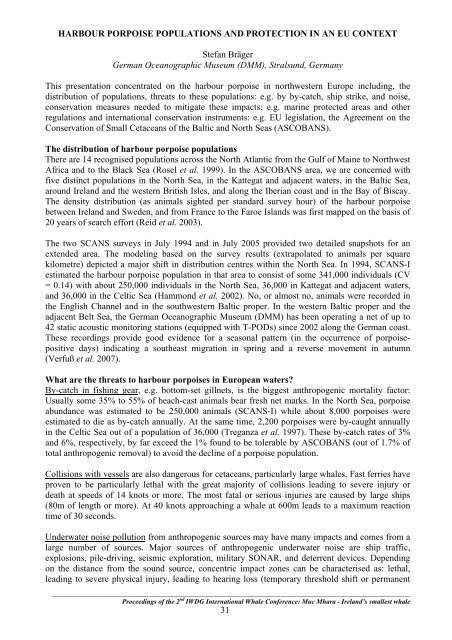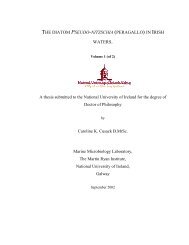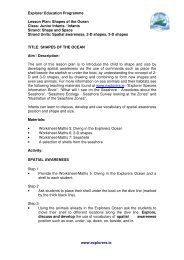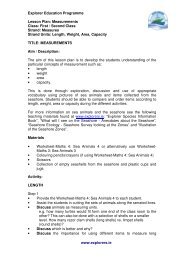Muc Mhara Ireland's Smallest Whale - Marine Institute Open Access ...
Muc Mhara Ireland's Smallest Whale - Marine Institute Open Access ...
Muc Mhara Ireland's Smallest Whale - Marine Institute Open Access ...
You also want an ePaper? Increase the reach of your titles
YUMPU automatically turns print PDFs into web optimized ePapers that Google loves.
HARBOUR PORPOISE POPULATIONS AND PROTECTION IN AN EU CONTEXT<br />
Stefan Bräger<br />
German Oceanographic Museum (DMM), Stralsund, Germany<br />
This presentation concentrated on the harbour porpoise in northwestern Europe including, the<br />
distribution of populations, threats to these populations: e.g. by by-catch, ship strike, and noise,<br />
conservation measures needed to mitigate these impacts: e.g. marine protected areas and other<br />
regulations and international conservation instruments: e.g. EU legislation, the Agreement on the<br />
Conservation of Small Cetaceans of the Baltic and North Seas (ASCOBANS).<br />
The distribution of harbour porpoise populations<br />
There are 14 recognised populations across the North Atlantic from the Gulf of Maine to Northwest<br />
Africa and to the Black Sea (Rosel et al. 1999). In the ASCOBANS area, we are concerned with<br />
five distinct populations in the North Sea, in the Kattegat and adjacent waters, in the Baltic Sea,<br />
around Ireland and the western British Isles, and along the Iberian coast and in the Bay of Biscay.<br />
The density distribution (as animals sighted per standard survey hour) of the harbour porpoise<br />
between Ireland and Sweden, and from France to the Faroe Islands was first mapped on the basis of<br />
20 years of search effort (Reid et al. 2003).<br />
The two SCANS surveys in July 1994 and in July 2005 provided two detailed snapshots for an<br />
extended area. The modeling based on the survey results (extrapolated to animals per square<br />
kilometre) depicted a major shift in distribution centres within the North Sea. In 1994, SCANS-I<br />
estimated the harbour porpoise population in that area to consist of some 341,000 individuals (CV<br />
= 0.14) with about 250,000 individuals in the North Sea, 36,000 in Kattegat and adjacent waters,<br />
and 36,000 in the Celtic Sea (Hammond et al. 2002). No, or almost no, animals were recorded in<br />
the English Channel and in the southwestern Baltic proper. In the western Baltic proper and the<br />
adjacent Belt Sea, the German Oceanographic Museum (DMM) has been operating a net of up to<br />
42 static acoustic monitoring stations (equipped with T-PODs) since 2002 along the German coast.<br />
These recordings provide good evidence for a seasonal pattern (in the occurrence of porpoisepositive<br />
days) indicating a southeast migration in spring and a reverse movement in autumn<br />
(Verfuß et al. 2007).<br />
What are the threats to harbour porpoises in European waters?<br />
By-catch in fishing gear, e.g. bottom-set gillnets, is the biggest anthropogenic mortality factor:<br />
Usually some 35% to 55% of beach-cast animals bear fresh net marks. In the North Sea, porpoise<br />
abundance was estimated to be 250,000 animals (SCANS-I) while about 8,000 porpoises were<br />
estimated to die as by-catch annually. At the same time, 2,200 porpoises were by-caught annually<br />
in the Celtic Sea out of a population of 36,000 (Treganza et al. 1997). These by-catch rates of 3%<br />
and 6%, respectively, by far exceed the 1% found to be tolerable by ASCOBANS (out of 1.7% of<br />
total anthropogenic removal) to avoid the decline of a porpoise population.<br />
Collisions with vessels are also dangerous for cetaceans, particularly large whales. Fast ferries have<br />
proven to be particularly lethal with the great majority of collisions leading to severe injury or<br />
death at speeds of 14 knots or more. The most fatal or serious injuries are caused by large ships<br />
(80m of length or more). At 40 knots approaching a whale at 600m leads to a maximum reaction<br />
time of 30 seconds.<br />
Underwater noise pollution from anthropogenic sources may have many impacts and comes from a<br />
large number of sources. Major sources of anthropogenic underwater noise are ship traffic,<br />
explosions, pile-driving, seismic exploration, military SONAR, and deterrent devices. Depending<br />
on the distance from the sound source, concentric impact zones can be characterised as: lethal,<br />
leading to severe physical injury, leading to hearing loss (temporary threshold shift or permanent<br />
_________________________________________________________________________________________________________<br />
Proceedings of the 2 nd IWDG International <strong>Whale</strong> Conference: <strong>Muc</strong> <strong>Mhara</strong> - Ireland’s smallest whale<br />
31





